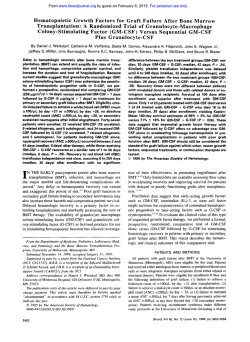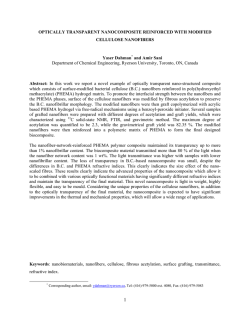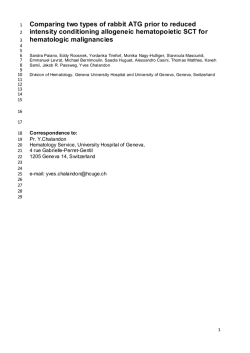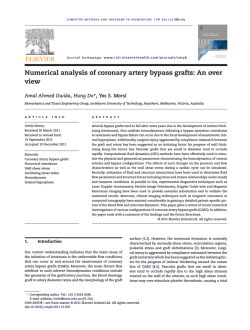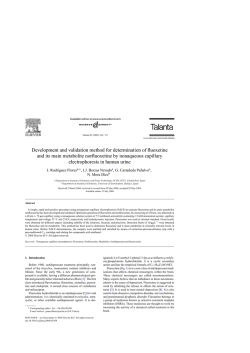
In Vivo Evaluation of Wound Bed Reaction and
ORIGINAL ARTICLE In Vivo Evaluation of Wound Bed Reaction and Graft Performance After Cold Skin Graft Storage: New Targets for Skin Tissue Engineering Alicia Knapik, MSc,* Kai Kornmann,* Katrin Kerl, MD,† Maurizio Calcagni, MD,* Christian A. Schmidt, MD, PhD,‡ Brigitte Vollmar, MD,§ Pietro Giovanoli, MD,* Nicole Lindenblatt, MD* Surplus harvested skin grafts are routinely stored at 4 to 6°C in saline for several days in plastic surgery. The purpose of this study was to evaluate the influence of storage on human skin graft performance in an in vivo intravital microscopic setting after transplantation. Freshly harvested human full-thickness skin grafts and split-thickness skin grafts (STSGs) after storage of 0, 3, or 7 days in moist saline at 4 to 6°C were transplanted into the modified dorsal skinfold chamber, and intravital microscopy was performed to evaluate vessel morphology and angiogenic change of the wound bed. The chamber tissue was harvested 10 days after transplantation for evaluation of tissue integrity and inflammation (hematoxylin and eosin) as well as for immunohistochemistry (human CD31, murine CD31, Ki67, Tdt-mediated dUTP-biotin nick-end labelling). Intravital microscopy results showed no differences in the host angiogenic response between fresh and preserved grafts. However, STSGs and full-thickness skin grafts exhibited a trend toward different timing and strength in capillary widening and capillary bud formation. Preservation had no influence on graft quality before transplantation, but fresh STSGs showed better quality 10 days after transplantation than 7-day preserved grafts. Proliferation and apoptosis as well as host capillary in-growth and graft capillary degeneration were equal in all groups. These results indicate that cells may activate protective mechanisms under cold conditions, allowing them to maintain function and morphology. However, rewarming may disclose underlying tissue damage. These findings could be translated to a new approach for the design of full-thickness skin substitutes. (J Burn Care Res 2013;XXX:00–00) Reconstructive surgery applies several methods to cover acute or chronic wounds. For skin defects, current options for coverage include not only the From the *Division of Plastic and Reconstructive Surgery, Department of Surgery, University Hospital Zurich, Switzerland; †Division of Dermatology, University Hospital Zurich, Switzerland; ‡Clinic for Cardiovascular Surgery, University Hospital Zurich, Switzerland; and §Institute for Experimental Surgery, University of Rostock, Germany. This study was financially supported by the Swiss National Science Foundation (SNF-Grant 310030_127366). The authors declare that they have no competing financial interests, commercial associations, or financial disclosures that might pose or create a conflict of interest with information presented in the article. The authors disclose funding from NIH, Welcome Trust, HHMI. Address correspondence to Nicole Lindenblatt, MD, Division of Plastic and Reconstructive Surgery, Department of Surgery, University Hospital Zurich, Raemistrasse 100, 8091 Zurich, Switzerland. Copyright © 2013 by the American Burn Association 1559-047X/2013 DOI: 10.1097/BCR.0b013e3182a226df standard procedure, which is split- or full-thickness skin grafting,1 but also the use of skin substitutes.2 Products currently applied and commercially available in clinical routine are acellular collagen dermal matrices (eg, Integra®, Matriderm®) or epidermal substitutes (Epicel®, Epibase®). Skin substitutes were extensively reviewed by Shevchenko et al3 and most of them specifically lack properties of full-thickness skin, that is, color match, skin appendices, pliability, elasticity, and most of all mechanical stability.4 It is obvious, that until today no successful full-thickness skin substitute design has been achieved. The presently available full-thickness constructs usually acquire only insufficient blood supply, leading to cell death in the substitute. Strategies to overcome this problem include prevascularization of skin substitutes,5 bioprinting and electrospinning of biomaterials including application of defined growth 1 Copyright © American Burn Association. Unauthorized reproduction of this article is prohibited. Journal of Burn Care & Research Month/XXX 2013 2 Knapik et al factor cocktails,6 and finally the use of stem cells.7,8 All these strategies aim at speeding up the time until skin substitutes obtain sufficient blood supply and cellular composition. In the clinical setting, surplus harvested skin grafts are commonly stored at low temperatures (4–6°C) in order to make use of them if rest defects occur.9 However, nowadays clinical institutions have to follow rules with regard to good clinical practice and good manufacturing practice. The European Parliament issued the 2004/23/EG guidelines in 2004 in order to improve tissue quality and to increase patient safety in the setting of human tissue preservation. These guidelines define the quality and safety standards required for donation, procurement, testing and processing, and preservation, storage, and distribution of human tissues and cells. The guidelines have a major impact on all aspects of tissue banking and transplantation and demand standardized tissue storage under controlled conditions.10,11 In a previous study we evaluated the effect of cold storage in moist gauze at 4 to 6°C on split-thickness skin graft (STSG) tissue integrity and viability, cell proliferation, apoptosis, and vascularization.12 Histologic findings showed a preserved integrity of the tissue over a period of 7 days. However, metabolic activity of the tissue decreased by 50% after day 3 of storage, indicating a slowed down oxygen consumption and viability. Metabolic activity stayed at this level until 14 days of storage at 4 to 6°C. Thus, stored skin grafts adjusted their metabolic demand under cold temperatures, prolonging survival without blood perfusion. The concept of lowering nutritional demand by lowering temperature is a known phenomenon in nature, namely it is encountered during hibernation in mammals.13 Many of the physiological extremes of hibernation would be expected to lead to apoptosis or necrosis in nonhibernating animals.14 The knowledge whether similar processes can potentially take place on human tissue—in this case in skin grafts—may open interesting possibilities to induce these mechanisms in skin substitutes. By this, the survival of skin substitutes grafted onto the human body could be prolonged during rewarming from the chilled and metabolically reduced state before complete acquisition of blood supply has been achieved. Therefore, it is the aim of this study to investigate the effect of storage of human STSGs at 4 to 6°C up to 7 days on their in vivo performance after transplantation in the modified dorsal skinfold chamber in SCID mice.15 Angiogenic reactions of the wound bed, capillary regression, and ingrowth of wound bed vessels into the graft were accounted for. Moreover, graft performance was determined by histological assessment. METHODS Patients and Split-Thickness Skin Graft/FullThickness Skin Graft Harvest The study was approved by the local ethics committee. Written and informed consent was given by every skin donor (n = 19). The age of the patients ranged from 28 to 71 years. Patients were excluded in case of skin illnesses. Healthy patients underwent different procedures of dermolipectomy (abdominoplasty, belt lipectomy, and thigh lift). STSGs of 300 µm thickness were taken from the specimen with an air-driven dermatome (Zimmer, Münsingen, Switzerland) and directly transplanted or stored for 3 and 7 days in saline-moisturized gauze at 4 to 6°C in the refrigerator. Full-thickness skin grafts (FTSGs) were harvested with a scalpel separating the dermis from the underlying fat layer and transplanted directly. Mouse Modified Dorsal Skinfold Chamber On approval by the local government, all experiments were carried out in accordance with the Swiss legislation on protection of animals and the EC directive 86/609/EEC for animal experiments. All animals received humane treatment, were housed in separate cages with a 12-hour light/dark cycle, and given water and food ad libitum. Microcirculation was studied in the modified dorsal skinfold chamber as described previously.15 B6.CB17-Prkdcscid/ SzJ mice (“SCID” mice, n = 18; Jackson Laboratories, Bar Harbour, ME) with a body weight of 23 to 27 g were anesthetized by an intraperitoneal injection of ketamine (90 mg/kg body weight) and xylazine (25 mg/kg body weight). Briefly, for chamber implantation, two symmetrical titanium frames were mounted on a dorsal skinfold of the animal. One skin layer was then completely removed in a circular area of 15 mm in diameter, and the remaining layers (consisting of striated skin muscle, subcutaneous tissue, and skin) were covered with a glass coverslip incorporated into one of the titanium frames. Before skin grafting, the animals were allowed a recovery period of 3 days. Then, skin and most parts of the hypodermal fat layer were carefully removed in a circular area of 7 mm in diameter from the back of the chamber, leaving the panniculus carnosus as wound bed. Because of technical reasons it was not possible to harvest STSGs in a reproducible way, and with comparable thickness from the highly elastic Copyright © American Burn Association. Unauthorized reproduction of this article is prohibited. Journal of Burn Care & Research Volume XXX, Number XXX Knapik et al 3 Figure 1. A, Intravital microscopy of the wound bed. Schematic view of the respective areas studied in the center and the periphery of the wound bed. B, Areas of histological determination of proliferation and apoptosis rate in the upper dermis (1–3), lower dermis (4–6) of the graft, and the host wound bed (7–9). and thin mouse skin. Therefore, we chose to transplant human skin grafts. Three different groups were defined (n = 5 per group): 1) freshly harvested human STSGs; 2) 3-day preserved STSGs; and 3) 7-day preserved STSGs. Further SCID mice (n = 3) received directly transplanted human FTSGs to compare the wound bed reaction with STSGs. Grafts were placed into the defect in the back of the chamber. By this, it was possible to visualize the microcirculation of the wound bed in vivo and to study the morphological changes of the vasculature resulting as a response to graft placement. Intravital Microscopy Repetitive intravital microscopic analyses of wound bed and skin graft were carried out regularly during a period of 10 days. Because of the density and thickness of human epidermis including a thick layer of keratinocytes, it was not possible to monitor the microvasculature in the graft itself. Microscopic images were taken at eight different areas within the center and the periphery of the wound bed (Figure 1A). After injection of 0.15 ml fluorescein isothiocyanate–labelled dextran (1%; MW 70000; Sigma-Aldrich, Munich, Germany) the microcirculation was visualized by intravital fluorescence microscopy (AxioScope.A1; Zeiss, Feldbach, Switzerland). Microscopic images were captured by a CCD camera (AxioCam HSm; Zeiss) using ×10 (N-Achroplan 10x/0,25, Zeiss) and ×20 (W N-Achroplan 20x/0,5; Zeiss) objectives in AxioVision Rel 4.8. Vessel morphology and angiogenic changes were monitored in capillaries of the muscular wound bed. Microcirculatory Analysis Microvascular perfusion was quantified offline by analysis of the digital images using a computerassisted image analysis system (CapImage; Zeintl Software, Heidelberg, Germany). This included the characterization of morphological vascular changes (vessel diameter, capillary density, and formation of angiogenic buds). Histopathological Evaluation of Tissue Integrity Ten days after transplantation the chamber content was harvested in total (ie, skin graft attached to wound bed) and fixed in 4% formalin and subsequently embedded in paraffin, according to standard procedures. Sections (4 µm) were stained with hematoxylin and eosin staining for general morphological aspect. Samples were scored concerning microscopic appearance by a dermatopathologist in a blinded fashion. The scoring system was adapted from the study by Başaran et al (Table 1).9 The score estimates morphologic changes of the epidermis and dermis as well as collagen orientation, inflammation based on leukocyte infiltration, and apoptosis of keratinocytes. The total score was calculated by adding the appropriate separate score of each parameter, resulting in a possible maximum score of 10. Table 1. Parameters for histological assessment of graft quality Microscopic Parameter Epidermal integrity Epidermal–dermal junction Collagen organization Inflammation Apoptotic keratinocytes Score 0 1 2 Destroyed Destroyed Partial Partial Normal Normal Amorph Disturbed Normal Complete Complete Similar to control Present None Normal Copyright © American Burn Association. Unauthorized reproduction of this article is prohibited. Journal of Burn Care & Research Month/XXX 2013 4 Knapik et al Immunohistochemical Evaluation of Human and Mouse Capillary Density Paraffin sections (4 µm) were stained with mouse antihuman CD31 (Dako, Glostrup, Denmark) or rat antimouse CD31 (Dianova, Hamburg, Germany), incubated and detected with ABC-Vectastain (Reactolab, Servion, Switzerland) stained using AP substrate or DAB chromogen (Dako), respectively. The antigen retrieval for human CD31 staining required a Proteinase K (Dako) digest, whereas the preparation for retrieval of mouse CD31 required a treatment in boiling ethylenediaminetetraacetic acid buffer (pH 9). Slides were scanned with the Mirax Midi Slide Scanner (Zeiss) under a ×20 dry objective. Pictures were taken with a 3CCD colour camera (1360 × 1024 pixels). Capillaries were counted in five random dermal areas of cross-sections of the skin. Immunohistochemical Assessment of Cell Proliferation Paraffin embedded sections (4 µm) were singlelabelled with rabbit antihuman Ki67 (Abcam, Cambridge, United Kingdom) after antigen retrieval in boiling citrate buffer, followed by antibody incubation and detection using ABC-Vectastain (Reactolab). Quantification of stained cells was performed by counting nine representative fields for each skin section in the upper dermis, deeper dermis, and the muscle using a ×40 objective (Figure 1B). The proliferation rate is expressed as the ratio of the number of proliferating cells divided by the total cell number. Determination of Cell Apoptosis Rate Apoptosis was assessed by in situ Tdt-mediated dUTP-biotin nick-end labelling, using a commercially available kit (Qbiogene, Illkirch, France). Quantification of stained cells was performed by counting representative fields for each skin in the lower dermis, deeper dermis, and the muscle section using a ×20 objective (according to Figure 1B); the apoptotic cell rate is given as proportion of the number of positive cells per total number of cells. Statistical Analysis Differences between values were assessed using oneway analysis of variance or Kruskall–Wallis tests followed by the appropriate post hoc comparison tests (Holm–Sidak and Dunn’s test, respectively). All data were expressed as means ± SEM and overall statistical significance was set at P <.05. RESULTS Comparison Wound Bed Reaction After Human Split-Thickness Skin Graft and FullThickness Skin Graft Transplantation In Vivo In order to exclude differences resulting from the nature of the placed graft, experiments comparing the angiogenic host response after FTSG and STSG placement were performed. Overall, there were no significant differences in wound bed reactions between STSG and FTSG. However, there was a tendency toward a different timing of host angiogenic response and its magnitude (Figure 2 A–C). After FTSG placement, host capillaries replied within 3 days with an extensive capillary widening, whereas the placement of an STSG led to a weaker and delayed response starting after 5 days. Host capillaries showed an early (day 3 posttransplantation) and strong bud formation in response to STSG, but a weaker and later (day 5 posttransplantation) reaction after FTSG placement. Capillary density was slightly higher after STSG placement and showed a similar development over time when compared with that after FTSG placement. Influence of Split-Thickness Skin Graft Preservation Time on Wound Bed Response In Vivo Intravital microscopy revealed that the host angiogenic response did not show any differences after the different storage periods. Neither capillary density (Figure 3A), nor capillary diameter (Figure 3B) or bud formation (Figure 3C) were significantly influenced by the time of graft storage. Capillary density for all three storage periods was in the normal range of the dorsal skinfold chamber (250–350 cm/cm2) and dropped slightly after transplantation. Angiogenic response symbolized by bud formation started after day 2 and regressed until day 10 in a similar manner in the three experimental groups. Capillary widening was weak and occurred after 6 days, comparable in all three groups. Influence of Preservation Time on Graft Integrity Skin grafts preserved for 7 days and transplanted into the dorsal skinfold chamber exhibited a significantly lower total graft score after 10 days than freshly transplanted skin grafts (Figure 4A and B). However, no significant difference in the graft score after storage of 0, 3, and 7 days was observed after 10 days, indicating that graft storage up to 7 days does not affect mere tissue integrity after transplantation. Copyright © American Burn Association. Unauthorized reproduction of this article is prohibited. Journal of Burn Care & Research Volume XXX, Number XXX Knapik et al 5 C Capillary density (cm/cm2) 400.00 Capillary diameter (um) Human FTSG 300.00 250.00 200.00 150.00 100.00 50.00 0.00 B Human STSG 350.00 0 3 5 7 10 Angiogenic wound bed reaction (buds n/mm2) A 16.00 Human STSG Human FTSG 14.00 12.00 10.00 8.00 6.00 4.00 2.00 0.00 0 14 3 5 7 10 14 Days after Tx Days 25.00 Human STSG Human FTSG 20.00 15.00 10.00 5.00 0.00 0 3 5 7 10 14 Days after Tx Figure 2. Comparison of the wound bed reaction between STSGs and FTSGs transplanted into SCID mice. Capillary density (A) and capillary diameter (B) in wound bed. Angiogenic response of the host (C). Means ± SEM. FTSGs, full-thickness skin grafts; STSGs, split-thickness skin grafts. C Capillary density (cm/cm2) 400.00 350.00 300.00 250.00 200.00 150.00 fresh skin 100.00 3d old skin 50.00 7d old skin 0.00 0 Capillary diameter (um) B 2 5 7 10 Days after Tx 25.00 Angiogenic wound bed reaction (bud n/mm2) A 25 fresh skin 3d old skin 20 7d old skin 15 10 5 0 0 3 5 7 10 Days after Tx Fresh skin 3d old skin 20.00 7d old skin 15.00 10.00 5.00 0.00 0 3 5 7 Days after Tx 10 Figure 3. Human split-thickness skin grafts (0, 3, and 7 days of preservation) transplanted into an SCID mouse. Capillary density (A) and capillary diameter (B) in wound bed. Angiogenic response of the host (C). Means ± SEM. Copyright © American Burn Association. Unauthorized reproduction of this article is prohibited. Journal of Burn Care & Research Month/XXX 2013 6 Knapik et al A 12 Total graft score 10 * 8 fresh skin 6 3d old skin 7d old skin 4 2 0 0 10 Days after Tx B Fresh STSG 7d old STSG Transplantation Figure 4. Histological evaluation of fresh and stored human STSGs 10 days after transplantation. A, Blinded pathological skin quality evaluation. *P ≤.05 day 0 vs day 10. B, Representative hematoxylin and eosin sections of fresh and preserved grafts before and 10 days after transplantation. STSGs, split-thickness skin grafts. The quality of the graft, scored by a dermatopathologist in a blinded fashion 10 days after graft placement, showed a constant and nearly linear decrease for all three storage periods starting from 10 points at the time of grafting (completely viable skin, 100%) and ending at 7.6 (24% decrease) for fresh skin, 6.4 (36% decrease) for 3-day preserved skin and 5.5 (45% decrease) for 7-day preserved skin, 10 days after grafting. However, values were only significant in the 7-day storage group. Influence of Preservation on Skin Graft Capillaries and Vascularization From the Wound Bed (Mouse Vasculature) The skin graft vasculature behaved in a similar manner in freshly transplanted and preserved grafts, exhibiting a decrease in the number of present vessels of 67.4% in directly grafted skin and 61.9% in 7-day preserved skin at day 10 (Figure 5A and B). The ingrowth of murine host capillaries was not influenced by the storage time of the graft and was slightly, but not significantly, higher in 7-day preserved skin samples when compared with freshly grafted skin (Figure 5C). In both cases murine capillaries were found in upper layers of the dermis in the graft (Figure 5D). Thus, replacement of host capillaries occurred in a similar manner after storage when compared with freshly transplanted skin grafts. Proliferation and Apoptosis Rates of Preserved Grafts After Transplantation Proliferation and apoptosis rates were determined by immunohistochemistry in three separate layers: muscle tissue of the wound bed, the lower dermis, on the border of wound bed and graft, and finally in the upper dermis, periphery of the graft. Our results show that the proliferation rate measured on day 10 after graft placement remains constant in the periphery, middle part, and wound bed in all three tested Copyright © American Burn Association. Unauthorized reproduction of this article is prohibited. Journal of Burn Care & Research Volume XXX, Number XXX C 20.00 Fresh skin 7d old skin * 18.00 16.00 * 14.00 12.00 10.00 8.00 6.00 4.00 2.00 0.00 0 Days after Tx 20.00 Number of mouse capillaries/0.5mm2 Number of human capillaries/0.5mm2 A Knapik et al 7 18.00 Fresh skin 7d old skin 16.00 14.00 12.00 10.00 8.00 6.00 4.00 2.00 0.00 10 10 days after Tx B D Epidermis Human STSG Fresh STSG Fresh STSG Host wound bed 7d old STSG 7d old STSG Human STSG Host wound bed 0 10 Figure 5. Evaluation of capillary density in STSGs 10 days after transplantation (A) human capillaries. B, Representative slides of human CD31 graft vasculature of fresh and preserved human STSGs before and 10 days after grafting. C, Mouse capillaries. D, Representative slides of mouse CD31 positive vasculature in fresh and preserved human STSGs 10 days after graft placement. *P ≤ .05 day 0 vs day 10. STSGs, split-thickness skin grafts. groups (Figure 6A). The preservation time of the graft did not influence the proliferation rate. Furthermore, we observed differences in the proliferation rate between the three defined layers: the upper dermis revealed ~×4 higher proliferation rates than the middle dermal part of the graft or the wound bed itself. The proliferation rate ranged between <1 and <8% depending on the layer, reaching the highest level in the upper part of the dermis. The rate of apoptotic cells in general remained on a low level. The results did not show significant differences among the investigated skin layers. Modern plastic and reconstructive surgery has to face and integrate the ongoing developments in tissue engineering in order to increase early wound coverage and reduce patient morbidity. This is particularly of importance for the treatment of severely burned patients, where often not enough autologous donor skin is available for transplantation and rapid sufficient defect coverage is urgently needed to increase patient survival.16 In this situation, often only skin allografts or xenografts are available for temporary B 12.00% Upper dermis Middle Dermis Muscle 10.00% 8.00% 6.00% 4.00% 2.00% 0.00% 0 3 Skin storage time (days) 7 Apoptosis (%) 10days after grafting Proliferation rate (%) 10 days after grafting A DISCUSSION 8.00% Upper dermis Middle Dermis Muscle 6.00% 4.00% 2.00% 0.00% 0 3 Skin storage time (days) 7 Figure 6. Proliferation (A) and apoptosis rate (B) of cells in wound bed (muscle) and grafts (upper and lower dermis) 10 days after grafting. Copyright © American Burn Association. Unauthorized reproduction of this article is prohibited. 8 Knapik et al coverage followed by a long recovery period, making use of the small amount of available skin by expansion and growth of keratinocyte sheets.17 Still, wound coverage and eventually skin quality after these procedures are far from satisfactory, resulting in numerous reoperations.18 In recent times medical centers also need to fulfill the requirements of “tissue directives” (2004/23/EC, 2006/17/EC, 2006/86/ EC), European regulations (2007/1394/EC), and local/national legislation.19 Olender et al18 pointed out that meeting the criteria set by law leads to considerable financial expenses to adapt facilities and train personnel. This in fact could become a limiting factor for small hospitals. However, many tissue banks have been involved in the procedure and directive development process and are already accordingly prepared. In addition, practitioners of young disciplines like tissue engineering, allograft revitalization, or stem cell–based therapies are fully aware of the legal regulations for future product requirements.20,21 Full-thickness skin substitutes were introduced into the clinic with the tissue-engineering era.22–24 However, none of these dermo-epidermal substitutes were able to overcome the problem resulting from the requirements of an FTSG to rapidly recruit adequate oxygen and nutrient supply. This issue often leads to total or partial tissue necrosis.25–27 In a previous experimental study we observed that the integrity and composition of preserved human skin grafts12 did not show deterioration after a storage period of up to 7 days in moist gauze at 4 to 6°C. Cell survival was equal in fresh and preserved grafts, but the metabolic rate was decreased by ~50% by day 3 after storage, indicating that cooling of the skin grafts reduced metabolism, leading to lower energy demands and a decreased susceptibility to lack of oxygen. This state could be regarded as a torpor-like state, as often seen in nature during hibernation.14 Cell division and migration, as well as protein translation and transcription, are arrested during torpor.28,29 In light of these findings it was the goal of this study to investigate the influence of human skin graft storage up to 7 days at 4 to 6°C and the reaction of the wound bed, in particular the angiogenic response in vivo. In the first step we compared the revascularization process of human FTSGs with that of human STSGs. Intravital microscopy results showed no significant differences with respect to angiogenic response and vascularity, even though there was a trend toward an earlier peak in wound bed angiogenesis in STSGs. This is in line with the observation of our previous studies investigating mouse FTSGs.15,30 Journal of Burn Care & Research Month/XXX 2013 However, capillary widening of the wound bed was much less pronounced after human skin graft application, when compared with the mouse model. This could at least in part also be attributed to the different mouse species (SCID) studied. The fact that there merely was a trend toward a different timing in capillary widening between FTSGs and STSGs may be accounted for by the small number of experiments. To our knowledge, no differences in the wound bed reaction between STSGs and FTSGs have been described before. Preservation of human STSGs up to 7 days did not influence the vascular response of the wound bed in vivo. Typical angiogenic changes such as capillary widening, increase of capillary density, and capillary bud formation, occurred independent of storage time in STSGs of all groups exhibiting the same timing and reaching similar magnitudes. From this it can be derived that the expression of angiogenic factors during storage most likely is not significantly increased indicating hypoxia-tolerance mechanisms within the skin grafts yet to be defined. Hypoxia and associated factors like HIF1α are highly capable of inducing angiogenesis.31,32 In a previous study we were able to show, that the hypoxic skin graft conveys a strong angiogenic effect onto the wound bed by up-regulating HIF1α and subsequently VEGF peaking within the first 72 hours and leading to sprouting angiogenesis.30 Because the angiogenic response of the wound was not different after skin graft storage it can be deducted that most likely HIF-1α expression was not significantly different, hinting at a similar level of tissue hypoxia. However, further studies are needed to investigate this hypothesis. Next to this, the present study illustrates that the preservation of skin grafts at 4 to 6°C for 7 days and subsequent transplantation into a warm organism resulting in rewarming of the STSG lead to significant changes in graft score and quality after 7 days of storage at 4 to 6°C. Of interest, histological graft score after storage of 7 days only, that is, without transplantation into the skinfold chamber, was not diminished.12 Thus, transplantation of the grafts into the warm mouse organism revealed potential damaging factors in vivo, which were not seen after storage and histological evaluation alone. This again points toward the hypoxiaprotective mechanisms with reduced metabolism during storage. Vascular ingrowth of wound bed vessels with subsequent partial replacement of existing graft vasculature has been shown to be a crucial step in skin graft healing and survival.33,34 In this study STSG Copyright © American Burn Association. Unauthorized reproduction of this article is prohibited. Journal of Burn Care & Research Volume XXX, Number XXX vasculature degeneration as well as vessel ingrowth from the mouse wound bed was similar for freshly harvested and 7-day stored skin grafts. This once again suggests a similar hypoxia-level within the skin graft before and after 7 days of storage. However, autochthonous human graft vessel count within the STSGs decreased significantly both for freshly transplanted and 7-day stored skin grafts, confirming vessel degeneration and replacement with host mouse vasculature over time. Mouse vessels were detected in the upper dermis of the human skin graft, depicting the complete vessel ingrowth from the wound bed. Last, immunohistological studies showed that proliferation and apoptosis in STSGs did not reveal significant differences after skin graft storage up to 7 days. Both rates were generally low and below 10% in all study groups. The phenomenon that cooling slows down degenerative processes and oxygen consumption is a well-known fact applied in clinical routine, for example, in heart surgery or neurosurgery.35,36 Our study and previous experiments suggest, that human skin grafts stored under severe conditions (4–6°C, up to 7 days without oxygen and nutrient supply) are not damaged and most likely equally hypoxic as fresh skin grafts. However, skin graft quality is slightly decreased after 7 days of storage and transplantation into a living organism. This suggests that even when a graft microscopically appears viable and without change in tissue composition after preservation, still underlying cell damage may be present. The actual performance of the skin graft in fact may only be revealed after transplantation into the living organism. We have shown in a previous study that cell viability of the skin graft dropped within the first 3 days of storage significantly to approximately 52%, reaching finally a value of 44.1% in comparison with fresh skin until 14 days of storage.12 This may in fact influence graft performance after transplantation and reveals an underlying tissue damage of the graft, if it is stored at 4 to 6°C in saline gauze. In accordance with solid organ preservation special nutrient media or conditions (eg, University of Wisconsin solution, histidine-tryptophan-ketoglutarate solution, Dulbecco’s Modified Eagle Medium, cryopreservation, etc)9,37 should be evaluated in this context to improve graft performance in vivo after storage. On the basis of this evaluation studies of new storage media also should be verified in an in vivo approach. Furthermore, the findings of the current study could be translated and used to design a new approach in skin tissue engineering by expression of hypoxia-tolerance–inducing factors in full-thickness skin substitutes. Knapik et al 9 ACKNOWLEDGMENTS This study was financially supported by the Swiss National Science Foundation (SNF-Grant 310030_127366). Drawings for Figure 1 were kindly provided by Stefan Schwyter, Technical Drawer, Graphics Department, University Hospital Zürich, Zürich, Switzerland. REFERENCES 1. Enoch S, Roshan A, Shah M. Emergency and early management of burns and scalds. BMJ 2009;338:b1037. 2. Böttcher-Haberzeth S, Biedermann T, Reichmann E. Tissue engineering of skin. Burns 2010;36:450–60. 3. Shevchenko RV, James SL, James SE. A review of tissueengineered skin bioconstructs available for skin reconstruction. J R Soc Interface 2010;7:229–58. 4. Mac Neil S. Progress and opportunities for tissue-engineered skin. Nature 2007; 445:874–80. 5. Laschke MW, Harder Y, Amon M, et al. Angiogenesis in tissue engineering: breathing life into constructed tissue substitutes. Tissue Eng 2006;12:2093–104. 6. Metcalfe AD, Ferguson MW. Bioengineering skin using mechanisms of regeneration and repair. Biomaterials 2007;28:5100–13. 7. Hodgkinson T, Bayat A. Dermal substitute-assisted healing: enhancing stem cell therapy with novel biomaterial design. Arch Dermatol Res 2011;303:301–15. 8. Chan RK, Zamora DO, Wrice NL, et al. Development of a vascularized skin construct using adipose-derived stem cells from debrided burned skin. Stem Cells Int 2012;2012:841203. 9. Başaran O, Ozdemir H, Kut A, et al. Effects of different preservation solutions on skin graft epidermal cell viability and graft performance in a rat model. Burns 2006;32:423–9. 10. Pruss A, von Versen R. [Influence of European regulations on quality, safety and availability of cell and tissue allografts in Germany]. Handchir Mikrochir Plast Chir 2007;39:81–7. 11. Council of Europe. Guide to safety and quality assurance for organs, tissues and cells. 2nd ed. Strasbourg: Council of Europe Publishing; 2004. 12. Knapik A, Kornmann K, Kerl K, et al. Practice of split-thickness skin graft storage and histological assessment of tissue quality. J Plast Reconstr Aesthet Surg 2013;66:827–34. 13. Buck CL, Barnes BM. Effects of ambient temperature on metabolic rate, respiratory quotient, and torpor in an arctic hibernator. Am J Physiol Regul Integr Comp Physiol 2000;279:R255–62. 14. Bouma HR, Verhaag EM, Otis JP, et al. Induction of torpor: mimicking natural metabolic suppression for biomedical applications. J Cell Physiol 2012;227:1285–90. 15. Lindenblatt N, Calcagni M, Contaldo C, Menger MD, Giovanoli P, Vollmar B. A new model for studying the revascularization of skin grafts in vivo: the role of angiogenesis. Plast Reconstr Surg 2008;122:1669–80. 16. Cirodde A, Leclerc T, Jault P, Duhamel P, Lataillade JJ, Bargues L. Cultured epithelial autografts in massive burns: a single-center retrospective study with 63 patients. Burns 2011;37:964–72. 17. Gaucher S, Duchange N, Jarraya M, et al. Severe adult burn survivors. What information about skin allografts? Cell Tissue Bank 2012; Epub ahead of print. 18. Lootens L, Brusselaers N, Beele H, Monstrey S. Keratinocytes in the treatment of severe burn injury: an update. Int Wound J 2013;10:6–2. 19.Olender E, IUhrynowska-Tyszkiewicz I, Kaminski A. Revitalization of biostatic tissue allografts: new perspectives in tissue transplantology transplantation proceedings. 2011;43:3137–41. Copyright © American Burn Association. Unauthorized reproduction of this article is prohibited. 10 Knapik et al 20. Karumbayaram S, Lee P, Azghadi SF, et al. From skin biopsy to neurons through a pluripotent intermediate under Good Manufacturing Practice protocols. Stem Cells Transl Med 2012;1:36–3. 21. Marazzi M, Crovato F, Bucco M, et al. GMP-compliant culture of human hair follicle cells for encapsulation and transplantation. Cell Transplant 2012;21:373–8. 22. Hartmann-Fritsch F, Biedermann T, Braziulis E, et al. Collagen hydrogels strengthened by biodegradable meshes are a basis for dermo-epidermal skin grafts intended to reconstitute human skin in a one-step surgical intervention. J Tissue Eng Regen Med 2012; Epub ahead of print. 23. Biedermann T, Böttcher-Haberzeth S, Klar AS, et al. Rebuild, restore, reinnervate: do human tissue engineered dermo-epidermal skin analogs attract host nerve fibers for innervation? Pediatr Surg Int 2013;29:71–8. 24.Leonardi D, Oberdoerfer D, Fernandes MC, et al. Mesenchymal stem cells combined with an artificial dermal substitute improve repair in full-thickness skin wounds. Burns 2012;38:1143–50. 25. Föhn M, Bannasch H. Artificial skin. Methods Mol Med 2007;140:167–82. 26. Priya SG, Jungvid H, Kumar A. Skin tissue engineering for tissue repair and regeneration. Tissue Eng Part B Rev 2008;14:105–18. 27. Auger FA, Berthod F, Moulin V, Pouliot R, Germain L. Tissue-engineered skin substitutes: from in vitro constructs to in vivo applications. Biotechnol Appl Biochem 2004;39(Pt 3):263–75. Journal of Burn Care & Research Month/XXX 2013 28. Kruman II. Comparative analysis of cell replacement in hibernators. Comp Biochem Physiol A Comp Physiol 1992;101:11–8. 29. Van Breukelen F, Martin SL. Invited review: molecular adaptations in mammalian hibernators: unique adaptations or generalized responses? J Appl Physiol 2002;92:2640–7. 30. Lindenblatt N, Platz U, Althaus M, et al. Temporary angiogenic transformation of the skin graft vasculature after reperfusion. Plast Reconstr Surg 2010;126:61–70. 31.Ahluwalia A, Tarnawski AS. Critical role of hypoxia sensor—HIF-1α in VEGF gene activation. Implications for angiogenesis and tissue injury healing. Curr Med Chem 2012;19:90–7. 32. Gruss CJ, Satyamoorthy K, Berking C, et al. Stroma formation and angiogenesis by overexpression of growth factors, cytokines, and proteolytic enzymes in human skin grafted to SCID mice. J Invest Dermatol 2003;120:683–92. 33. Calcagni M, Althaus MK, Knapik AD, et al. In vivo visualization of the origination of skin graft vasculature in a wild-type/ GFP crossover model. Microvasc Res 2011;82:237–45. 34. Knapik A, Hegland N, Calcagni M, et al. Metalloproteinases facilitate connection of wound bed vessels to pre-existing skin graft vasculature. Microvasc Res 2012;84:16–3. 35. Tissier R, Ghaleh B, Cohen MV, Downey JM, Berdeaux A. Myocardial protection with mild hypothermia. Cardiovasc Res 2012;94:217–25. 36. Song SS, Lyden PD. Overview of therapeutic hypothermia. Curr Treat Options Neurol 2012;14:541–8. 37. Ge L, Sun L, Chen J, et al. The viability change of pigskin in vitro. Burns 2010;36:533–8. Copyright © American Burn Association. Unauthorized reproduction of this article is prohibited.
© Copyright 2025
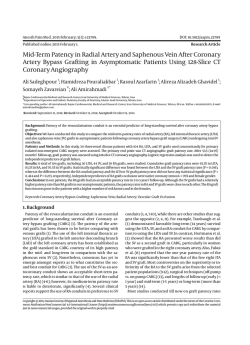
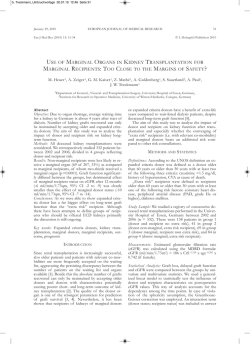
![Download [ PDF ] - journal of evolution of medical and dental sciences](http://s2.esdocs.com/store/data/000470394_1-e8c5a2ebb5ad45c9e89c84cc855201a0-250x500.png)
